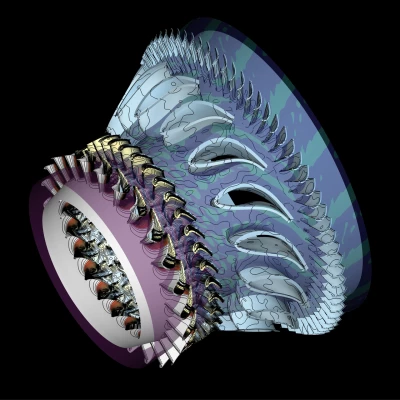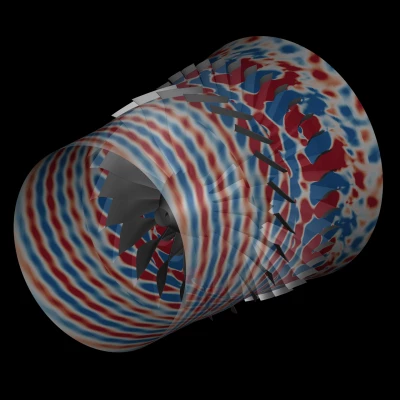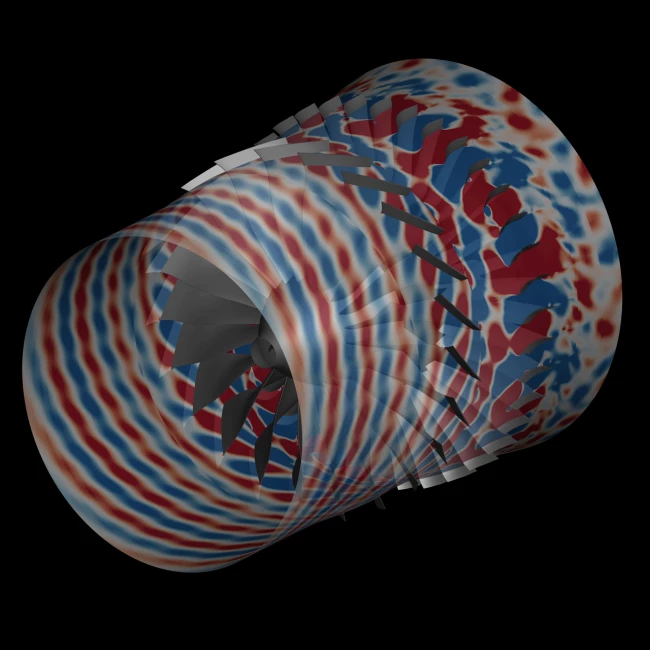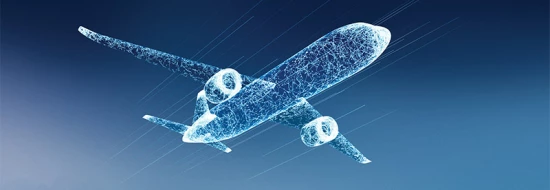innovation
Turbo simulation for engine development
Engines should be quiet, fuel-efficient, low-emission, and safe – and come to market faster. Accelerating the simulation of aerodynamic flows should help.
10.2019 | author: Monika Weiner | 4 mins reading time
author:
Monika Weiner
has been working as a science journalist since 1985. A geology graduate, she is especially interested in new developments in research and technology, and in their impact on society.
No air, no propulsion. The highly complex design of an engine is ultimately intended to direct air into the right channels: to take it in, compress it, and then combine it with fuel and ignite it in the core engine. In the final step, energy is extracted from this highly energized air in the low-pressure turbine, thus giving the fan the necessary power to generate thrust. In designing these engines, developers aim to optimize the flow of air because this one factor determines the engine’s efficiency and noise output as well as key constraints on the components’ service life.
On-screen engine development


The HB method makes it possible to carry out the complex full wheel calculations with the time domain solver for verification up to 2 orders of magnitude faster.

The HB method makes it possible to carry out the complex full wheel calculations with the time domain solver for verification up to 2 orders of magnitude faster.
The development engineers at MTU Aero Engines can evaluate these interrelationships even before a single component is manufactured and tested: they have a simulation program that provides all the information they need. Any change to the shape of the turbine or compressor blades is reflected on the screen in a 3D image of the flow lines representing the movement of the air. A keyboard command is all it takes to call up the temperature of the blades, as well as the pressure acting on the front and back side. Using this information, the program calculates the design’s efficiency. At the same time, it determines which vibrations the components are exposed to during operation and whether acoustic waves are generated that cause prohibited noise pollution.
The simulation software that makes all this possible was developed by MTU engineers together with researchers from the Institute of Propulsion Technology at the German Aerospace Center (DLR). “DLR, one of our most important technology partners, is a leader in propulsion technology and contributes the latest findings in aerodynamics, aeroacoustics and aeroelastics research,” explains Dr. Edgar Merkl, who is responsible for technology partnerships at MTU. For more than 20 years, the teams have been working together on TRACE – Turbomachinery Research Aerodynamic Computational Environment. “This simulation tool allows us to very quickly map and evaluate flow processes and their effects on the overall system in detail. This helps us to develop products with aerodynamically optimized designs.”
Tailored solutions
Manufacturers of gas turbines and engines worldwide use simulation programs. They are called “flow solvers” because they calculate solutions for complicated flow fields. “However, the commercially available programs usually offer only standardized solutions. TRACE, on the other hand, is tailored to our very special requirements and is constantly being refined. Thanks to our strategic collaboration with DLR, we have unrestricted rights of use – a real competitive advantage,” Merkl says.
Through close interaction with MTU, we have access to industrial aerospace programs and we are constantly receiving feedback from the field.
DLR benefits from the cooperation, too: “Through our close exchange with MTU, we have access to industrial aerospace programs and receive constant feedback from the field,” explains Dr. Edmund Kügeler of the DLR Institute of Propulsion Technology. “The test results and user validations help us refine the models further.”
Calculations that go beyond classical mathematics
Year after year, TRACE became increasingly effective. Today, the simulation tool helps map both laminar and turbulent air flows as well as their temporal progression, i.e., the fourth dimension. “The calculations are extremely complex. They are based on nonlinear equations that cannot be solved with pencil and paper. You need to use numerical methods that gradually approach the answer following a long series of calculation steps,” explains Dr. Nina Wolfrum. She is the engineer heading the aero‑CFD methods team at MTU. CFD stands for Computational Fluid Dynamics. To simulate the flow ratios in turbines or compressors, the simulation program has to carry out numerical calculations for millions of points.
The simulation tool TRACE allows the optimization of engines. The Harmonic Balance module accelerates calculations by a factor of one hundred.
TRACE can provide aerodynamic designers with a four‑dimensional flow model within a matter of hours. A mathematical trick helps here: flows in the engine change periodically. For example, rotating and stationary components in the turbine and compressor move relative to each other, but always the same way in a circle. This periodicity is exploited by the “harmonic balance (HB) method.” As Wolfrum explains: “The flow solution is represented by overlapping waves. The time course of the flow in an engine can usually be described with just a few of these waves,” she says.
“As a result, the program can calculate flow models a hundred times faster than with classical temporal resolution methods.”
Long-term goal: Virtual test stand @ DLR‑SG
The new, fast simulation methods are already helping aerodynamic designers optimize turbine and compressor blades. For MTU’s strategists, however, this also marks a further step towards their long‑term goal of simulating the entire engine. “A virtual test stand like this would help us make engines as a whole even more efficient, reliable and economical, with lower emissions,” Merkl summarizes. MTU is pursuing this goal in cooperation with the DLR Institute of Test and Simulation for Gas Turbines (DLR‑SG), which was founded in 2018. “TRACE plays a key role in this.”










